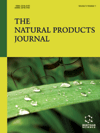- Home
- A-Z Publications
- Natural Products Journal, The
- Previous Issues
- Volume 13, Issue 1, 2023
Natural Products Journal, The - Volume 13, Issue 1, 2023
Volume 13, Issue 1, 2023
-
-
The Curcumin and Gingerol Combination as an Immune Regulator and Anti-Inflammatory Agent of SARS-CoV Infection According to a Nutrigenomic Approach: A Mini-Review
More LessAuthors: Ketut A. Adrianta and I G. B. SomantaraIntroduction: The COVID-19 pathophysiology caused by SARS-Cov-2 is closely related to immunoregulation and the process of inflammation. There are therapeutic targets in both, which are ideal for the healing process of infected patients. Phytonutrients are closely related to nutrigenomics. Curcumin and gingerol are two types of phytonutrients that have been studied, researched, and developed as therapeutic agents for dis Read More
-
-
-
Borneol: A Plant-Sourced Terpene with a Variety of Promising Pharmacological Effects
More LessAuthors: Amarjitsing Rajput, Aditi Kasar, Shruti Thorat and Madhur KulkarniBackground: Borneol, a bicyclic monoterpene belonging to the class of camphene, is sourced from Blumea balsamifera, Cinnamonum camphora (L.) Presl, Dryobalanops aromatica Gaertner, and the volatile oils extracted from various other plant sources. Chinese Traditional Medicine system documents almost 1000 years of clinical use of borneol as an adjuvant as well as an active in treating various diseases and disorders, m Read More
-
-
-
Cytotoxic and Anti-proliferative Effects of Moringa oleifera Lam. on HeLa Cells
More LessAuthors: Krishnambal Govender, Indres Moodley and Raveen ParboosingBackground: The aim of the study was to determine the mechanism of Moringa oleifera-induced apoptosis in HeLa cells. HeLa cells over-express cyclin E and cyclin B1, abrogate G0-G1 and G2-M cell cycle arrest, promoting tumorigenesis. Cyclin E, cyclin B1, E2F1 and telomerase expression, and caspase-3 and -7 activation were assessed after 24-treatment with M. oleifera leaf fractions. Methods: Apoptosis through caspase-3 Read More
-
-
-
Comparison of HPLC and ATR-FTIR Methods for the Determination of Rosmarinic Acid in Aqueous Leaf Extract of Orthosiphon stamineus.
More LessAuthors: Chow J. Chen and Gabriel Akyirem AkowuahBackground: Rosmarinic Acid (RA) is an important natural bioactive compound widely distributed in food plants. ATR-FTIR and HPLC methods for comparative determination of RA in aqueous methanolic extracts of Orthosiphon stamineus leaf samples are described. Methods: The quantitative determination of RA was performed by using HPLC with UV detection at 340 nm and ATR-FTIR based on peak height location at 1712.29 Read More
-
-
-
Vitamin C and D Supplements to Prevent the Risk of COVID-19
More LessAuthors: Mohamad H. Shahrajabian, Qi Cheng and Wenli SunBackground: A virus is a tiny agent, around one-hundredth the size of a bacterium which can infect cells of plants and animals. Seven coronaviruses are known to infect humans; three of them are serious, namely, SARS (severe acute respiratory syndrome, China, 2002), MERS (Middle East respiratory syndrome, Saudi Arabia, 2012), and SARS-CoV-2 (COVID-19) (2019-2020). SARS-CoV and MERS-CoV belong to beta coronavir Read More
-
-
-
The Role of Peroxidases in the Bioremediation of Organic Pollutants
More LessAuthors: Dencil Basumatary, Hardeo Singh Yadav and Meera YadavThe emergence of organic pollutants such as phenolic acids, pesticides, dyes, petrochemicals, pharmaceuticals, and industrial wastes threatens our environment, including biodiversity, ecosystems of terrestrial and aquatic animals, and human health. It is well known that toxicants disrupt the biochemical balance of organisms and cause physiological effects in individuals. Emerging Organic Pollutants (OPs) have varied levels of Read More
-
-
-
Antidiabetic Properties of Nymphaea Species (Water Lilies): A Review
More LessAuthors: A. H. M. Safayet Ullah Prodhan and Farzana S. MriduDiabetes mellitus is a highly prevalent metabolic disease specified by increased blood glucose and impaired insulin function. Various antidiabetic drugs are currently being used, but plant sources of antidiabetic agents are of recent scientific interest as they possess multitarget effects and the most negligible side effects. Nymphaea species (water lilies) have long been traditionally taken as food and antidiabetic agents. Growing Read More
-
Most Read This Month
Article
content/journals/npj
Journal
10
5
false
en


